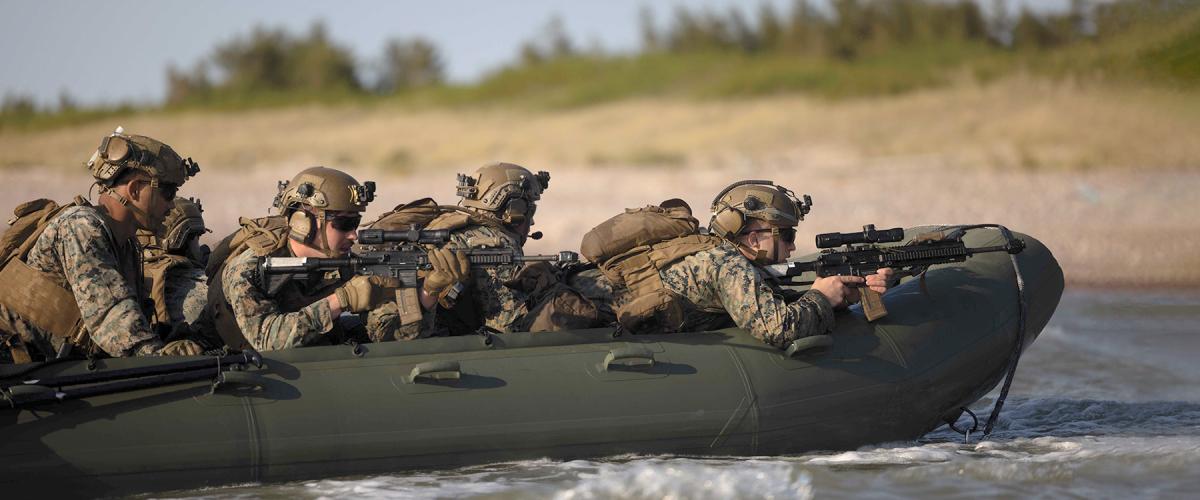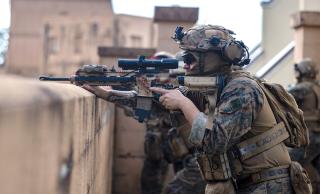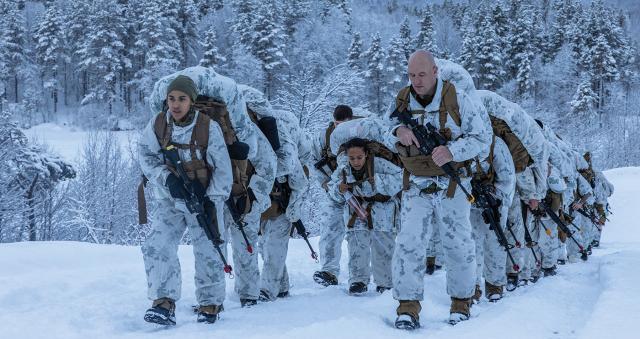Colonel Pat Garrett, U.S. Marine Corps (Retired), and Lieutenant Colonel Frank Hoffman, U.S. Marine Corps Reserve (Retired)

Maneuver warfare is a fraud, and maneuver as a warfighting function is dead. At least, that is what some scholars and military analysts claim. We disagree. However, there are ongoing changes in the character of war fueling perceptions that should be addressed. Warfare’s changing character often alters the balance between offense and defense, and the U.S. military faces one of these periodic shifts today.
These changes require professionals to think creatively about the implications. As warfare evolves, remaining ready in the face of technological change is key to the profession of arms. The challenges posed in today’s operating environment complicate maneuver and should stimulate updates to Marine Corps Doctrinal Publication (MCDP) 1: Warfighting.
Current Debate

A U.S. Marine with the Maritime Special Purpose Force, 26th Marine Expeditionary Unit, provides security in an urban environment training course on Marine Corps Base Camp Lejeune, North Carolina, in November 2022. While there are higher costs for urban operations, both movement and offensive maneuver are still possible in steel and masonry canyons. U.S. Marine Corps.
Since its post-Vietnam advent, maneuver warfare has always been a contested concept, despite its successful imprint on U.S. Marine Corps and Army doctrine.1 The roots of this 40-plus year argument can be traced back to the post–World War I writings of Basil Liddell Hart.2 The war’s massive human and matériel toll, accentuated by both sides’ pursuit of attrition strategies, propelled his search for alternatives that might produce more decisive results at reduced costs. Over the course of history, Hart found, “in all decisive campaigns, the dislocation of the enemy’s psychological and physical balance has been the vital prelude to his overthrow.”3 This concept of dislocation lies at the heart of today’s maneuver warfare.4
Attrition as a strategy received further criticism after Vietnam, where the decade-long U.S. attempt to wear down North Vietnam’s war-making abilities manifestly failed to achieve its desired aim, even though the United States had overwhelming combat and logistical superiority. Both the Army and Marine Corps turned their conceptual focus back to the burgeoning Soviet threat in Europe and the Middle East. The Army’s AirLand Battle concept sought to leverage new technologies, especially deep-attack systems, integrated with mechanized maneuver forces.5 Prompted by writings from Vietnam veterans, as well as ideas from Bill Lind and John Boyd, the Marine Corps began to explore maneuver warfare.6 The latter stressed decision-making and cognitive factors often overlooked in U.S. military theory.7 Despite the status it has achieved in Marine Corps doctrine, maneuver warfare has generated critics over the past decade.8
Several scholars have recently resurrected this debate, once again underscoring attrition and the physical destruction of an adversary as a surer path to victory. These critics have three substantial arguments. First, including the term “cognitive paralysis” as a method or goal in emerging concepts is suspect. This evolution from dislocation to paralysis appeared in the emerging Army multidomain operations concept.9 Academics have found trying to gain “strategic paralysis” against major competitors problematic. They contend that imposing multiple dilemmas to paralyze an enemy must be rethought in favor of attrition, explicitly questioning the historical basis of Hart and Boyd’s writings.10
Second, they argue the changing character of war makes maneuver harder to execute successfully.11 The proliferation of new intelligence, surveillance, target-acquisition, and reconnaissance capabilities makes offensive maneuver easier to detect and robs maneuver warfare of any chance of surprise.
Finally, they contend maneuver warfare is irrelevant to urban operations, which they presume to be a prominent future operating environment given the record density of population in cities.12 More than 55 percent of the world now lives in a city, and the World Bank projects that level will exceed two-thirds by 2050.13 This density seems to make canalizing ground formations inevitable, which appears to offset the mobility advantages of mechanized armies.14
What the Critics Get Right
Today’s attrition advocates are correct that technology trends improve targeting and surveillance and enhance the range and precision of strike assets. The “sense-to-strike” function is now a tightly compressed kill chain.15 Offensive maneuver forces will be hard pressed to obtain decisive results. This will be particularly true for offensive operations that require penetrating prepared and layered defenses, such as seen in the Russia-Ukraine war.16 The critics also are correct in noting the importance of endurance, logistics, and munitions inventories.17
The critics are right about the aspirational stretch behind strategic paralysis, too, and will be happy to hear that the Army has dropped it as a theory of victory. That service’s latest doctrine now states:
Multidomain operations fracture the coherence of threat operational approaches by destroying, dislocating, isolating, and disintegrating their interdependent systems and formations, and exploiting the opportunities these disruptions provide to defeat enemy forces in detail.18
While the primacy given to destruction in this definition may satisfy the critics, more important is the emphasis on four different and parallel defeat mechanisms in pursuit of disruption and the reduced coherence of the adversary’s ability to command. Marine Corps doctrine has been aligned with this since 1997.19
Why Attrition Is Insufficient
The firepower/attrition versus maneuver argument is a red herring. Black and white distinctions between destruction and maneuver, or physical and psychological effects, are oversimplified and overlook the interactive and reciprocal effects of actual combat. Attrition is too often used as a synonym for fires, which by themselves are a necessary but rarely sufficient component in warfare.20 Reducing an adversary’s capability is required to produce the shock or loss that induces him to recognize that the campaign cannot be continued. Under certain circumstances, a strategy of attrition may be necessary and effective.21 More often, the synergy of combinations is needed.
Second, arguments about the growing difficulty of conducting maneuver given the ongoing technology revolution are not easily dismissed. The current technological shift favors defense.22 Yet, the same was true in 1863 at Gettysburg, 1904–5 in Manchuria, and along the Western Front from 1914 to 1918. Following each battle, the military profession evolved its tactics and weapons to regain maneuver on the battlefield.23 Yet, there are situations in which offensive maneuver is required: to recover a salient, improve positional advantage, or overcome an attempted fait accompli against a U.S. ally.24 The challenge is how to design a force that can generate both fires and maneuver to succeed in an operating environment that privileges the defense.
Critics too often conflate the maneuver warfare concept with maneuver/movement. The former “seeks to shatter the enemy’s cohesion through a variety of rapid, focused, and unexpected actions.”25 Rapid movement is part of it, but so is firepower/destruction. The key is to avoid applying fires purely in an extended grinding down of an enemy’s defenses and instead focus on rendering the enemy incapable of effective counteraction “by shattering their moral, mental, and physical cohesion—their ability to fight as an effective, coordinated whole.”26
Third, attrition is a two-edged sword; like tempo, it is relational. It is not a one-sided game. Ultimately, it is a function of interaction with an opponent who is attempting to reduce U.S. capacity as well. Current Marine Corps doctrine does not ignore attrition; in fact, it explicitly recognizes that modern warfare “often involves extremely high attrition of selected enemy forces.” The distinction is that the focus is not on a slow and expensive reduction of the enemy’s matériel, but on the disruption it causes. Instead of pursuing the cumulative destruction of each enemy platform as the victory mechanism, the aim is “to attack the enemy ‘system’”—to incapacitate the enemy systemically.”27
Finally, urbanization is a legitimate concern; urban combat somewhere in the future is a near certainty.28 The experiences of Mogadishu, Fallujah, and Mosul give plenty of cause for concern. However, maneuver into and around cities is feasible, including air, subterranean corridors, and riverine options. True, there are many “surfaces” and higher costs for urban operations, but both movement and offensive maneuver are possible, if often difficult, in steel and masonry canyons.29 Moreover, urban operations are hard for a defender whose command and logistics likewise can be isolated and exploited. There are ways to crack this nut if the Marine Corps prepares for it, including unmanned and remote options.30 Understanding the “flows” of urban systems is important, and unmanned systems and sensor packages can help facilitate effective fire and maneuver.31
Yet, while attrition may be necessary, it is not on its own sufficient. Truly monodimensional solutions are theoretically possible but historically rare. We do not discount the value of fires, but the record for liberating territory and achieving decisive results purely through attrition is thin at best.32 Even in the most grinding campaigns, outcomes typically turn on the degree to which attrition and maneuver successfully complement each other. Instead of a return to the costly and stagnant operational designs that sparked Hart’s writings, there are several promising elements for a combination approach, one focused on the disruption of the adversary’s ability to direct the combination of fires and maneuver—a true system-disruption objective.

U.S. Marines with Combat Logistics Battalion 2, Combat Logistics Regiment 2, 2nd Marine Logistics Group, conduct a three-mile hike during Marine Rotational Force-Europe 23.1 in Setermoen, Norway, in January 2023. The Marine Corps must design a force that can generate both fires and maneuver to succeed in any operating environment. U.S. Marine Corps.
The Solution
Given favorable terrain and time for proper preparation, ongoing developments in sensing, precision, and speed of engagement favor the defense. Force design and doctrine must account for that. Mobile and armored platforms are needed but must be rethought with respect to weight, speed, sensing, and firepower tradeoffs.33
Technology, especially robotics, affords options that allow offensive maneuver to offset the inherent advantages of the defense.34 No single approach is likely to be effective alone, especially crossing the more transparent “dead zone” across future battlefields. As General Sir Patrick Sanders, Chief of the General Staff of the British Army, underscores: “Success will be determined by combined arms and multi-domain competence.”35
Former Chairman of the Joint Chiefs of Staff, Army General Mark Milley, finds this consistent with the new U.S. Joint Warfighting Concept, which calls for expanded maneuver as a key tenet.36 This challenges commanders to think creatively about “maneuver through land, sea, air, space, cyber, the electromagnetic spectrum, information space, and the cognitive realm.”37
To succeed, maneuver forces increasingly will need to employ unmanned systems. Improved mobile air defense and counter–unmanned aerial systems will facilitate maneuver, while robotics, lethal autonomous unmanned aerial and ground vehicles, and advanced electronic warfare capabilities will enable mobility. These unmanned systems can maneuver in swarms and complicate targeting, forcing expenditure of high-cost munitions to kill cheaper unmanned systems.38 Ultimately, these trends mean that “maneuver” will be reflected across the full array of warfighting domains.
The ongoing fight in Ukraine offers a glimpse of the future. Some military analysts characterize the war as attrition-based and the antithesis of maneuver warfare. Some even see Ukraine’s ongoing counteroffensive as a strategy of attrition.39 Certainly, the war has featured intensive expenditures of artillery ammunition.40 But the stunning Ukrainian counteroffensive to capture Kharkiv in September 2022 should be seen as an exemplar of maneuver warfare given the feints, deception, High Mobility Artillery Rocket System strikes, and maneuver forces used. Operational surprise was used against weak Russian elements (a gap) that led to their rapid collapse.41 As noted in Time:
The Russians were caught off guard. Many fled in disarray, leaving behind weapons and equipment. Local reports painted a humiliating picture of retreat, describing soldiers stealing civilians’ clothes, bicycles, and cars to escape. In six days, the Ukrainian military retook an estimated 3,000 square km of Russian-held territory, including strategically important rail hubs used to resupply its forces.42
This was classic dislocation and a manifestation of maneuverist thinking. As Russian operations against Kyiv clearly demonstrate, firepower is not enough.43
Today, Ukraine is doing much more than just matching Russia’s methods. Admiral Sir Tony Radakin, the United Kingdom’s Chief of Defence Staff, recently characterized Ukraine’s latest approach as “starve, stretch and strike.” In the first phase, the Ukrainians struck deep against Russian command-and-control nodes and logistics to dislocate its commanders and starve the defenders of supplies. In the “stretch” phase, the Ukrainians are probing Russian lines seeking gaps and forcing Russian reactions that are potential mistakes. In the culminating phase, precision fires and full domain maneuver from the trained assault brigades and overhead drones will exploit the defender’s disrupted defense. Liddell Hart would be satisfied.
No comments:
Post a Comment